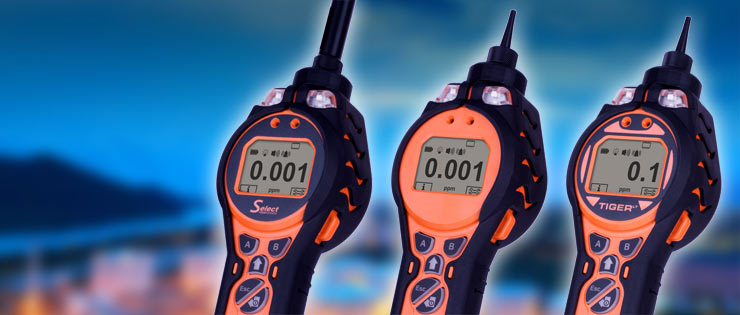
Ion Science Tiger PID handheld gas detectors utilise patented Fence Electrode technology, a 3-electrode format that resists humidity and contamination.
Whether for industrial hygiene, leak detection, or HazMat response, the Ion Science Tiger range delivers the most advanced VOC monitoring capabilities on the market.
The Tiger models of PID gas detectors from Ion Science have a dynamic detection range of 1 PPB to 20,000 PPM, a rapid response time, and built-in correction factors for more than 260 compounds.
- Fence Electrode technology: Tiger’s photoionisation detection (PID) capabilities use patented Fence Electrode technology, a 3-electrode format with increased resistance to humidity and contamination.
- Fast response: The Tiger VOC detector has the fastest response time on the market – just two seconds. And it is just as quick to clear down.
- USB connectivity: Tiger gas detectors can be connected directly to a PC via the USB, offering extremely fast data download capabilities.
- One hand: Ion Science Tiger offers simple, one-handed operation for easy VOC detection.
- Rugged: Its rugged design and protective, removable rubber boot withstand the harshest environments.
- Display: The large, clear back-lit display allows for easy viewing in any light condition.
- Torch: An integrated torch is designed for directing the detector’s probe into dimly-lit areas.
Ion Science have 3 Tiger model variants to choose from and many accessories to cater for different applications. We can also customise locally to suit New Zealand applications.

Tiger Select handheld benzene gas detector: A revolutionary handheld VOC gas detector with two-mode operation for the rapid detection of benzene and Total Aromatic Compounds (TACs) giving accurate data you can rely on.

Tiger handheld humidity-resistant VOC gas detector: Rapid, accurate detection of volatile organic compounds (VOCs). Provides the widest detection range of any VOC gas detector on the market – from 1 ppb to 20,000 ppm.

TigerLT handheld VOC gas detector: A streamlined, entry-level version of the highly popular Tiger VOC Detector, with all the essential functions and best available photoionisation detection (PID) sensor. Low on cost but high on performance.
Ion Science Tiger Gas Detector Range |
Tiger Select Benzene & TAC Gas Detector |
Tiger VOC Gas Detector |
TigerLT VOC Gas Detector |
| PID independently verified as best performing on the market* | Yes | Yes | Yes |
| Gas detection range – VOCs | – | 1 ppb to 20,000 ppm for specific volatiles | 0.1 to 5,000 ppm for specific volatiles |
| Gas detection range – Benzene | 0 to 200 ppm (in tube mode) |
– | – |
| Gas detection range – TACs | 0 to 20,000 ppm (gas dependent) |
– | – |
| Patented humidity resistance to: | 99% RH | 99% RH | 99% RH |
| Response Time | T90 < 2 seconds (TAC mode) |
T90 < 2 seconds | T90 < 2 seconds |
| Anti-contamination design that extends run time and minimises drift and downtime | Yes | Yes | Yes |
| Fastest 2-second response time and rapid clear down | Yes | Yes | Yes |
| Designed for easy use and service | Yes | Yes | Yes |
| Patented Fence Electrode technology | Yes | Yes | – |
| Exposure monitoring | Yes | Yes | – |
| Accurate results in all environments | Yes | Yes | Yes |
| Detects VOCs | Yes | Yes | Yes |
| Detects Benzene & TACs | Yes | – | – |
| Easy change miniPID Detector, Electrode Stack and Lamps | Yes | Yes | Yes |
| Batteries certified to be changed within hazardous areas | Yes | Yes | Yes |
| Battery life | up to 24 hours | up to 24 hours | up to 24 hours |
| Loud audible sounders | 95 dBA | 95 dBA | 95 dBA |
| Bright LED and vibration alarms | Yes | Yes | Yes |
| Intrinsically Safe Approvals | ATEX, IECEx, CUL | ATEX, IECEx, CUL | ATEX, IECEx, UL, CSA |
| Warranty | 2 years | 2 years | 2 years |
| * Independently verified by the State of Maine’s Department of Environmental Protection (ME DEP). Click here for Ion Science’s supporting press release. |
|||
For further information and pricing, contact us or fill out the enquiry form at the top of this page.
Related Products
Find out more about the Tiger range of handheld PID gas detectors at the Ion Science website here.